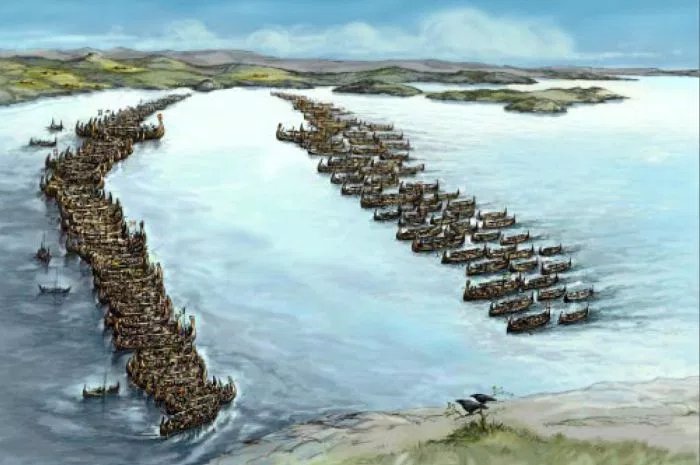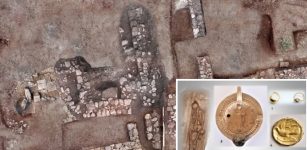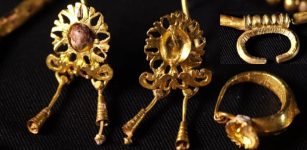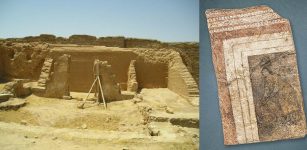Sverd I Fjell – Swords In Rock: Battle Of Hafrsfjord Won By Harald Fairhair – First King Of Norway
A. Sutherland - AncientPages.com - Three huge Viking swords tower over Hafrsfjord just outside Stavanger, Norway. This extraordinary artwork - Sverd I Fjell (Swords in Rock) was created to commemorate Norway's unification as a single kingdom in 872.
The three swords are more than just a tourist attraction. The monument is of great historical importance. The memorial was made by Friz Røed (1928-2002) and unveiled by King Olav in 1983.
Sverd i Fjell – Stavanger's impressive Viking monument. Image source.
It commemorates the Battle of Hafrsfjord in 872. It was at this place that Harald Fairhair (Norwegian: Harald Hårfagre) fought a battle that united Norway into one kingdom in 872 AD.
King Harald Fairhair - First King Of Norway
Harald Fairhair reigned from c. 872 to 930 and is today recognized as the first King of Norway.
Little is known about this royal personality. Although Harald's life is described in several of the Kings' sagas, they were written around three centuries after his lifetime. The lack of existing sources makes it very difficult to reconstruct his life.
The accounts of Harald and his life differ on many points, and some of the content may be uncertain. However, it is clear that in the 12th and 13th centuries, Harald played a crucial role
 Harald Fairhair, in an illustration from the 14th century Flateyjarbók. Image credit: Tokle - Public Domain
Harald Fairhair, in an illustration from the 14th century Flateyjarbók. Image credit: Tokle - Public Domain
In the early Middle Ages, Norway was divided into many small kingships. According to the sagas, Harald Fairhair (ca. 865 – ca. 933) united Norway into a single kingdom and played a crucial role in this political process.
The Battle of Hafrsfjord, which supposedly took place in about 885, is regarded as decisive in the unification of Western Norway. The battle is described in the Saga of Harald Fairhair in Snorri's Heimskringla.
According to Snorri's saga, King Harald Fairhair defeated several kings, but even before the battle, he controlled large parts of southeast Norway.
Other sources claim that the eastern part of Norway was under the Danish king. The Battle of Hafrsfjord marks the final crushing of opposition from Norway's southwestern portion.
 The The naval battle in Hafrsfjord in about 872 AD is one of the largest in the history of Norway (Photo: Sola Historielag)
The The naval battle in Hafrsfjord in about 872 AD is one of the largest in the history of Norway (Photo: Sola Historielag)
It made it possible for King Harald to subdue the country and collect taxes from a large part of it. Many defeated who would not submit to Harald's rule emigrated to Iceland.
Winning the Battle of Hafrsfjord resulted in King Harald I of Norway's declaration to become the sole ruler of Norway. This battle may have been the largest in Norway up to that time and for a good while afterward.
The King's sons, Eric Bloodaxe and Haakon the Good, succeeded Harald in becoming kings after his death.
When we look at the three swords in the rock, we should not forget that they represent peace, unity, and freedom.
Written by – A. Sutherland - AncientPages.com Senior Staff Writer
Copyright © AncientPages.com All rights reserved. This material may not be published, broadcast, rewritten or redistributed in whole or part without the express written permission of AncientPages.com
Expand for referencesReferences:
Thor News - Searching for Traces of the Battle of Hafrsfjord – 872 AD
The Stavanger Region – Swords in Rock
Heimskringla, The Chronicle of the Kings of Norway
More From Ancient Pages
-
 Unusual Stone Carvings And Medieval ‘Witching’ Marks To Ward Off Evil Spirits Discovered In England
Archaeology | Oct 29, 2020
Unusual Stone Carvings And Medieval ‘Witching’ Marks To Ward Off Evil Spirits Discovered In England
Archaeology | Oct 29, 2020 -
 World’s Oldest Shipwreck Discovered In Mediterranean
Archaeology | Apr 10, 2019
World’s Oldest Shipwreck Discovered In Mediterranean
Archaeology | Apr 10, 2019 -
 28,000-Year-Old Lapedo Child: Human-Neanderthal Hybrid Reveals A Prehistoric Secret
Evolution | Mar 10, 2025
28,000-Year-Old Lapedo Child: Human-Neanderthal Hybrid Reveals A Prehistoric Secret
Evolution | Mar 10, 2025 -
 A Huge Site Dated To Roman-Era Unearthed In Reims (Marne), France
Archaeology | Mar 20, 2023
A Huge Site Dated To Roman-Era Unearthed In Reims (Marne), France
Archaeology | Mar 20, 2023 -
 Long-Lost Tomb Of Pharaoh Thutmose II Finally Found In Luxor, Egypt
Archaeology | Feb 19, 2025
Long-Lost Tomb Of Pharaoh Thutmose II Finally Found In Luxor, Egypt
Archaeology | Feb 19, 2025 -
 Extremely Rare And Tiny Biblical Coins Discovered Near The Temple Mount
Archaeology | May 30, 2018
Extremely Rare And Tiny Biblical Coins Discovered Near The Temple Mount
Archaeology | May 30, 2018 -
 Ruins Of Long-Lost Ancient City Of Tenea Built By Trojans Discovered
Archaeology | Nov 21, 2018
Ruins Of Long-Lost Ancient City Of Tenea Built By Trojans Discovered
Archaeology | Nov 21, 2018 -
 10,000-Year-Old Seeds Offer First Evidence Of Farming In A Green Sahara
Archaeology | Mar 19, 2018
10,000-Year-Old Seeds Offer First Evidence Of Farming In A Green Sahara
Archaeology | Mar 19, 2018 -
 Lost Ancient Mayan Cities Lagunita And Tamchen Hidden In The Jungle Reveal Their Secrets
Featured Stories | Jun 25, 2017
Lost Ancient Mayan Cities Lagunita And Tamchen Hidden In The Jungle Reveal Their Secrets
Featured Stories | Jun 25, 2017 -
 The Third Greatest Fire Temple That Existed In Ancient Iran’s Sassanid Age – Unearthed
Archaeology | Jul 8, 2022
The Third Greatest Fire Temple That Existed In Ancient Iran’s Sassanid Age – Unearthed
Archaeology | Jul 8, 2022 -
 Earliest Evidence Of A 260-Day Maya Calendar Found Inside Guatemalan Pyramid
Archaeology | Apr 14, 2022
Earliest Evidence Of A 260-Day Maya Calendar Found Inside Guatemalan Pyramid
Archaeology | Apr 14, 2022 -
 Death Of Norse God Balder And Loki’s Mischief That Led To Destruction In Ragnarok
Featured Stories | Nov 15, 2016
Death Of Norse God Balder And Loki’s Mischief That Led To Destruction In Ragnarok
Featured Stories | Nov 15, 2016 -
 Lugh – Mighty God Of Light, Sun And Crafts In Celtic Beliefs
Celtic Mythology | Apr 30, 2018
Lugh – Mighty God Of Light, Sun And Crafts In Celtic Beliefs
Celtic Mythology | Apr 30, 2018 -
 Ancient Secrets Of The Amazon Jungle – The Man Who Stepped Into The Unknown Searching For The Lost City Of The Gods – Part 2
Ancient Mysteries | Mar 5, 2019
Ancient Secrets Of The Amazon Jungle – The Man Who Stepped Into The Unknown Searching For The Lost City Of The Gods – Part 2
Ancient Mysteries | Mar 5, 2019 -
 Mysterious Code Hidden In Antique Silk Dress Bought In Maine Finally Deciphered!
Artifacts | Jan 23, 2024
Mysterious Code Hidden In Antique Silk Dress Bought In Maine Finally Deciphered!
Artifacts | Jan 23, 2024 -
 Norse God Tyr Who Gave Viking Warriors Courage And Self-Confidence In Battle
Featured Stories | Mar 7, 2018
Norse God Tyr Who Gave Viking Warriors Courage And Self-Confidence In Battle
Featured Stories | Mar 7, 2018 -
 Roman-Era Girl Buried And Adorned With 1,700-Year Old Gold Jewelry Found In Pagan Cave
Archaeology | Apr 8, 2023
Roman-Era Girl Buried And Adorned With 1,700-Year Old Gold Jewelry Found In Pagan Cave
Archaeology | Apr 8, 2023 -
 Mysterious Leaden Sarcophagus Found Under Notre Dame Will Be Opened
Archaeology | Apr 17, 2022
Mysterious Leaden Sarcophagus Found Under Notre Dame Will Be Opened
Archaeology | Apr 17, 2022 -
 Ancient Romans Invented The First Bound Book
Ancient History Facts | Sep 25, 2017
Ancient Romans Invented The First Bound Book
Ancient History Facts | Sep 25, 2017 -
 Has World’s Oldest Image Of Virgin Mary Been Discovered In Dura-Europos Church?
Archaeology | Mar 17, 2017
Has World’s Oldest Image Of Virgin Mary Been Discovered In Dura-Europos Church?
Archaeology | Mar 17, 2017

